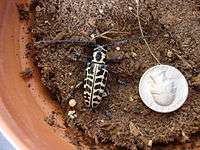Cottonwood borer
The cottonwood borer (Plectrodera scalator) is a species of longhorn beetle found in the United States east of the Rocky Mountains that feeds on cottonwood trees.[3] It is one of the largest insects in North America, with lengths reaching 40 millimetres (1.6 in) and widths, 12 mm (0.47 in). It is the only species in the genus Plectrodera.[4]
| Plectrodera scalator | |
|---|---|
 | |
| Cottonwood Borer next to quarter for size reference. | |
| Scientific classification | |
| Kingdom: | |
| Phylum: | |
| Class: | |
| Order: | |
| Family: | |
| Subfamily: | |
| Genus: | Plectrodera Dejean, 1837 |
| Species: | P. scalator |
| Binomial name | |
| Plectrodera scalator | |
Description
The adult cottonwood borer is a large longhorn beetle with a black-and-white coloration and black antennae as long or longer than the body.[5] The white portions are due to microscopic masses of hair.[6] The larvae have legless, cylindrical, creamy-white bodies with a brown-to-black head and grow up to 38 millimetres (1.5 in) long.
Life cycle
The female cottonwood borer will chew small pits in the base of the tree in which to lay her eggs. The larvae can take up to two years to mature, after which they pupate in a root below ground level for approximately three weeks. Once metamorphosis has completed, the now-adult chews its way out of the root and digs up to the surface.[6]
Environmental impact
Although larvae can kill young trees by girdling them, infested mature trees are usually not seriously injured. The larvae can also structurally weaken a young tree, which is then more susceptible to falling over in high winds. Adults feed on leaf stems and the bark of tender shoots, occasionally causing flagging.[5]
References
- "Plectrodera scalator (Fabricius, 1792)". Integrated Taxonomic Information System.
- Biolib.cz - Plectrodera scalator. Retrieved on 8 September 2014.
- Eaton, Eric R.; Kenn Kaufman (2007). Kaufman field guide to insects of North America. Houghton Mifflin Harcourt. pp. 174–175. ISBN 978-0-618-15310-7.
- Earle Gorton Linsley & John A. Chemsak (1984). Cerambycidae of North America. Part VII, No. 1: Taxonomy and Classification of the Subfamily Lamiinae, Tribes Parmenini Through Acanthoderini, Volume 114. Volume 102 of UC Publications in Entomology. University of California Press. ISBN 978-0-520-09690-5.
- "Cottonwood Borer." Texas A&M. http://insects.tamu.edu/fieldguide/bimg177.html Archived 2012-01-07 at the Wayback Machine Retrieved 2012-02-24.
- "Cottonwood Borer." Great Plains Nature Center. http://www.gpnc.org/cwoodborer.htm Retrieved 2012-02-24.